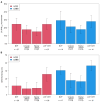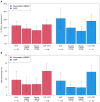Multicenter Hemodynamic Assessment of the LOT-CRT Strategy: When Does Combining Left Bundle Branch Pacing and Coronary Venous Pacing Enhance Resynchronization?: Primary Results of the CSPOT Study
- PMID: 39440428
- PMCID: PMC11575906
- DOI: 10.1161/CIRCEP.124.013059
Multicenter Hemodynamic Assessment of the LOT-CRT Strategy: When Does Combining Left Bundle Branch Pacing and Coronary Venous Pacing Enhance Resynchronization?: Primary Results of the CSPOT Study
Abstract
Background: Left bundle branch area pacing (LBBAP) may be an alternative to biventricular pacing (BVP) for cardiac resynchronization therapy (CRT). We sought to compare the acute hemodynamic and ECG effects of LBBAP, BVP, and left bundle-optimized therapy CRT (LOT-CRT) in CRT candidates with advanced conduction disease.
Methods: In this multicenter study, 48 patients with either nonspecific interventricular conduction delay (n=29) or left bundle branch block (n=19) underwent acute hemodynamic testing to determine the change in left ventricular pressure maximal first derivative (LV dP/dtmax) from baseline atrial pacing to BVP, LBBAP, or LOT-CRT.
Results: Atrioventricular-optimized increases in LV dP/dtmax for LOT-CRT (mean, 25.8% [95% CI, 20.9%-30.7%]) and BVP (26.4% [95% CI, 20.2%-32.6%]) were greater than unipolar LBBAP (19.3% [95% CI, 15.0%-23.7%]) or bipolar LBBAP (16.4% [95% CI, 12.7%-20.0%]; P≤0.005). QRS shortening was greater in LOT-CRT (29.5 [95% CI, 23.4-35.6] ms) than unipolar LBBAP (11.9 [95% CI, 6.1-17.7] ms), bipolar LBBAP (11.7 ms [95% CI, 6.4-17.0]), or BVP (18.5 [95% CI, 11.0-25.9] ms), all P≤0.005. Compared with patients with left bundle branch block, patients with interventricular conduction delay experienced less QRS reduction (P=0.026) but similar improvements in LV dP/dtmax (P=0.29). Bipolar LBBAP caused anodal capture in 54% of patients and resulted in less LV dP/dtmax improvement than unipolar LBBAP (18.6% versus 23.7%; P<0.001). Subclassification of LBBAP capture (European Heart Rhythm Association criteria) indicated LBBAP or LV septal pacing in 27 patients (56%) and deep septal pacing in 21 patients (44%). The hemodynamic benefit of adding left ventricular coronary vein pacing to LBBAP depended on baseline QRS duration (P=0.031) and success of LBBAP (P<0.004): LOT-CRT provided 14.5% (5.0%-24.1%) greater LV dP/dtmax improvement and 20.8 (12.8-28.8) ms greater QRS shortening than LBBAP in subjects with QRS ≥171 ms and deep septal pacing capture type.
Conclusions: In a CRT cohort with advanced conduction disease, LOT-CRT and BVP provided greater acute hemodynamic benefit than LBBAP. Subjects with wider QRS or deep septal pacing are more likely to benefit from the addition of a left ventricular coronary vein lead to implement LOT-CRT.
Registration: URL: https://www.clinicaltrials.gov; Unique identifier: NCT04905290.
Keywords: bundle-branch block; cardiac resynchronization therapy; electrocardiography; hemodynamics; pacemaker.
Conflict of interest statement
Dr Jastrzębski: speaker/consultant honoraria from Abbott, Biotronik, Boston Scientific, and Medtronic. Dr Foley: consultant to Medtronic, proctor for Medtronic. Dr Chandrasekaran: honoraria, consultancy fees and funding support from Medtronic, Biotronik, and Abbot. Dr Whinnett: speaker honoraria, consulting fees, and institutional fellowship/research support from Abbot, Boston Scientific, and Medtronic. Dr Vijayaraman: Medtronic: honoraria, consultant, research and fellowship support Abbott: honoraria, consultant Boston Scientific/Biotronik: honoraria; patent: HBP delivery tool. Dr Upadhyay: consulting and speaker honoraria from Abbott, Biotronik, Boston Scientific, GE Healthcare, Medtronic, Philips, Rhythm Science, and Zoll Medical. R.D. Schaller: speaking honoraria for Medtronic. Dr Richardson: consulting and speaking honoraria from Medtronic, Inc. Dr Herweg: fellowship support from Medtronic, speaker for Medtronic and Abbott. Dr Stadler, D. Kudlik, R. Waxman, Dr Zimmerman, J. Burrell, and Dr Cornelussen are Medtronic employees. The other authors report no conflicts
Figures






References
-
- Su L, Wang S, Wu S, Xu L, Huang Z, Chen X, Zheng R, Jiang L, Ellenbogen KA, Whinnett ZI, et al. . Long-term safety and feasibility of left bundle branch pacing in a large single-center study. Circ Arrhythm Electrophysiol. 2021;14:e009261. - PubMed
-
- Zhang W, Huang J, Qi Y, Wang F, Guo L, Shi X, Wu W, Zhou X, Li R. Cardiac resynchronization therapy by left bundle branch area pacing in patients with heart failure and left bundle branch block. Heart Rhythm. 2019;16:1783–1790. doi: 10.1016/j.hrthm.2019.09.006 - PubMed
-
- Kim JA, Kim SE, Ellenbogen KA, Vijayaraman P, Chelu MG. Clinical outcomes of conduction system pacing versus biventricular pacing for cardiac resynchronization therapy: a systematic review and meta-analysis. J Cardiovasc Electrophysiol. 2023;34:1718–1729. doi: 10.1111/jce.15976 - PubMed
-
- Herweg B, Sharma PS, Cano O, Ponnusamy SS, Zanon F, Jastrzebski M, Zou J, Chelu MG, Vernooy K, Whinnett ZI, et al. . Arrhythmic risk in biventricular pacing compared with left bundle branch area pacing: results from the I-CLAS study. Circulation. 2024;149:379–390. doi: 10.1161/CIRCULATIONAHA.123.067465 - PubMed
-
- Vijayaraman P. Left bundle branch pacing optimized cardiac resynchronization therapy: a novel approach. JACC Clin Electrophysiol. 2021;7:1076–1078. doi: 10.1016/j.jacep.2021.04.005 - PubMed
Publication types
MeSH terms
Associated data
LinkOut - more resources
Full Text Sources
Medical
Research Materials

